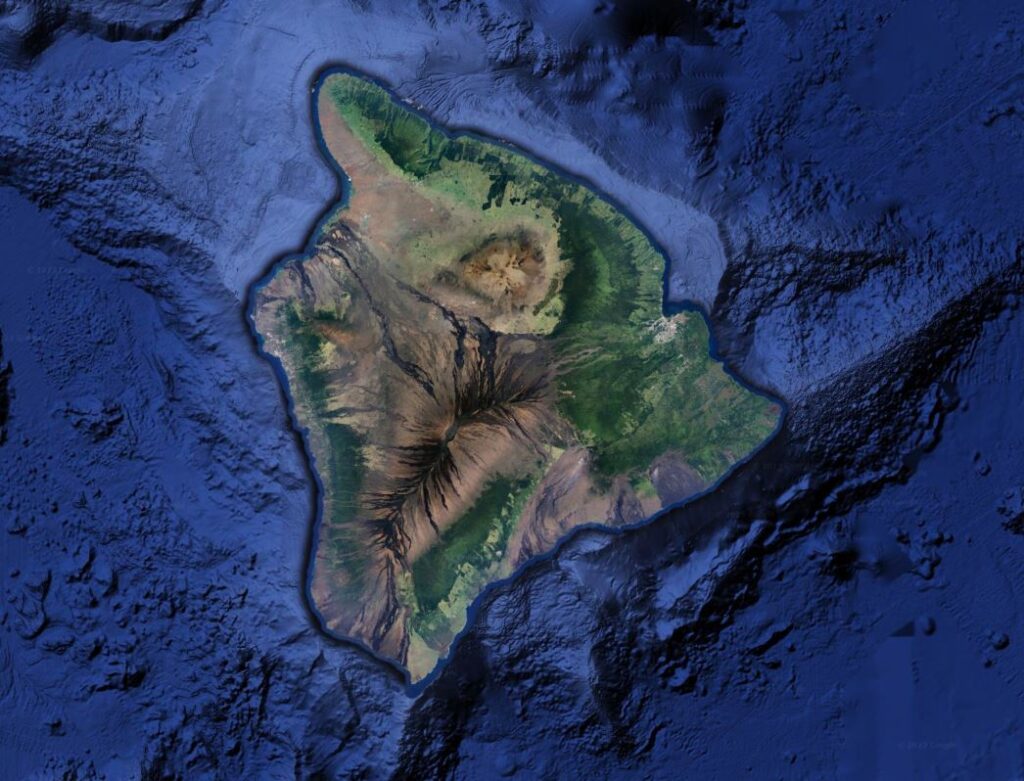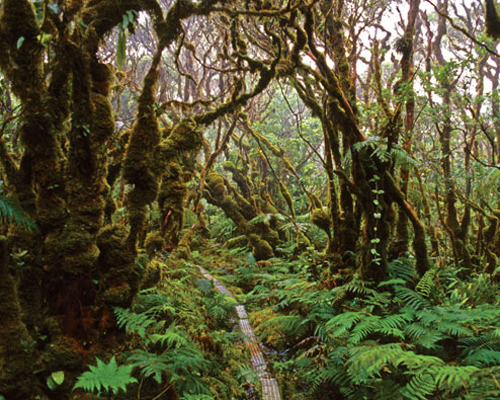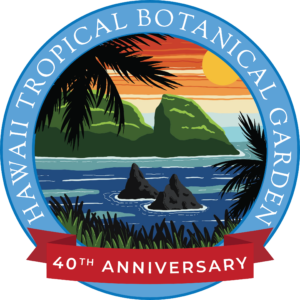
THE RAINFOREST
The Natural Environment
The outstanding features of Hawaii’s many climate zones include mild temperatures throughout the year, moderate humidity, persistence of northeasterly trade winds, significant differences in rainfall within short distances, and infrequent severe storms.
As you travel around the Big Island, check out the change of climate zones such as tropical monsoon, tundra, and desert within an hour drive.

Hawaii is within the tropics which accounts for the relative uniformity through the year in length of day, solar energy and temperature. Hawaii's longest and shortest days are about 13 1/2 hours and 11 hours, respectively, compared with 14 1/2 and 10 hours for Southern California and 15 1/2 hours and 8 1/2 hours for Maine.
The ocean provides moisture to the air and acts as a giant thermostat. Its temperature varies little compared to areas with large land masses. The seasonal range of ocean surface temperature near Hawaii is only about 6°. Hawaii's warmest months are not June and July, but August and September. Its coolest months, are not December and January, but February and March, reflecting the seasonal lag in the ocean's temperature.
Hawaii's mountains significantly influence every aspect of its weather and climate. The endless variety of peaks, valleys, ridges, and broad slopes, gives Hawaii a climate that is different from the surrounding ocean, as well as a climatic variety within the islands. These climatic differences would not exist if the islands were flat and the same size.
The open sea near Hawaii reaches rainfall averages between 25-30 inches a year. The “orographic,” or mountain-cause rains, forms within the moist trade-wind air as it moves in from the sea and overrides the steep and high terrain of the islands. Another source of rainfall is from cumulus clouds that build over the mountains on calm sunny afternoons. These shows are forceful but brief.
Its peak is 4,207.3 m (13,803 ft) above sea level, making it the highest point in the state of Hawaii
Mauna Loa is among Earth's most active volcanoes, having erupted 34 times since its first well-documented historical eruption in 1843.
Hawai‘i Volcanoes National Park protects some of the most unique geological, biological, and cherished cultural landscapes in the world. Extending from sea level to 13,680 feet, the park encompasses the summits of two of the world's most active volcanoes - Kīlauea and Mauna Loa - and is a designated International Biosphere Reserve and UNESCO World Heritage Site.
Kailua-Kona is on the western slopes of the Hualālai volcano next to the ocean. North of the village where the weather gets drier you can find gorgeous beaches, the resort coast, and world-famous golf courses.
A busy farming and fishing area in early times, Hilo evolved into a commercial center for the sugar industry in the 1800s. Downtown Hilo was built around its crescent-shaped bay and became the seat of county government. Today, Downtown Hilo is a charming town offering museums, art galleries, shops and restaurants.
The above product is a condensed chapter on Hawaii’s climate from the Second Edition (University of Hawaii Press, 1983) of the “Atlas of Hawaii.” The author is the late Saul Price, former Hawaii State Climatologist and Staff Meteorologist for the National Weather Service Pacific Region.
THE RAINFOREST
Rainforests are Earth’s oldest living ecosystems. Though it only covers 6% of the Earth’s surface, rainforests are incredibly diverse and complex, home to more than half of the world’s plant and animal species. Tropical rainforests are mainly located between the latitudes of Tropic of Cancer and the Tropic of Capricorn. Tropical rainforests are found in Central and South America, western and central Africa, western India, Southeast Asia, the island of New Guinea, and Australia.
TYPICAL RAINFOREST LAYERS

Most rainforests are structured in four layers: emergent, canopy, understory, and forest floor. Each layer has unique characteristics based on differing levels of water, sunlight, and air circulation:
Emergent layer: This layer gets the most sunlight. Colorful birds and butterflies fly above the trees. Small mammals swing through the branches.
Canopy layer: Only a few rays of sunlight shine through this later. Many small mammals such as sloths and monkeys, and birds such as owls and toucans, live here.
Understory layer: This layer is home to many plant and animal species. With a lot of shade in this later, snakes, amphibians, bats and all types of plants thrive here.
Forest-floor layer: The lowest layer in the rainforest. Leaves from the layers above block the sunlight making this layer dark and damp. Insects and rodents move around on the dirt floor.
Image by Bruno Kelly for Reuters
Hawaii's tropical rainforest

Hawaii’s tropical rainforests vary in elevations. Moist to wet forests are commonly found on the windward lowland, montane areas on larger islands and mountain tops of smaller islands. They cover an area of 6,700 km² (2,600 sq mi).
Tropical moist forests of Hawai’i occur as mixed mesic forests (about 750–1,250 m elevation), rain forests (found above mixed mesic forests up to 1,700 m), wet shrublands, and bogs in swampy areas. There are forty-eight different forest types found in the Hawaiian Islands.
Native Hawaii rainforest consists of 3 layers:
Canopy layer: Dominated by ohia lehua and acacia koa.
Understory layer: Consists of a variety of smaller trees and shrubs.
Forest-floor layer: Consists mostly of ferns (hapu’u) and berries.
Image by randy fujimoto for maui no ka oi magazine
THE EVER-CHANGING CLIMATE
RAINFORESTS TODAY

Due to human presence, lowland and foothill moist forests have been largely eliminated. There is degradation from feral ungulates (plant-eating 4-footed hoofed mammals), development, and recreational activities in montane forests. Introduced weed and tree species, avian malaria, invasive ants, rats, frogs, toads, pigs, goats, and cats all modify native habitats and harm threatened wildlife populations.
PHOTO: National Geographic
WHY RAIN IS NECESSARY

The hot, wet weather of the rainforest helps to add water to the atmosphere. It accomplishes this through the many different plants and trees releasing water from their leaves into the air. The moisture from the leaves is then absorbed, or soaked up, into the air. In turn, it can lead to the forming of rain clouds. The clouds then release the moisture in the form of rain. This cycle occurs over and over and over again. This ongoing process helps the rainforests stay healthy and green — which means that the plants can grow, animals can eat and so the ecosystem of the rainforest is in balance.
PHOTO: Ryan Aguilar, Hawaii Department of Land and Natural Resources
HAWAII'S RAIN THROUGH THE DECADES

Isolated in the Pacific Ocean, the Hawaiian Islands’ freshwater resources are limited, and understanding the impacts of changes in climate on the freshwater supply is crucial. From 1920 to 2012, over 90% of the state experienced drying trends, with Hawai‘i Island, and in particular the western part of the island, experiencing the largest significant long-term declines in annual and dry season rainfall.
The western part of Hawai’i Island had constant annual rain precipitation and dry season trends. While other in regions, drying trends were significant, especially in recent decades.
CHART: Rainfall Atlas of Hawai’i, Geography Department – University of Hawaii at Mānoa
HTBG IN THE RAINFOREST
Over the years, the Garden has developed into a living classroom where photographers, botanists, gardeners, scientists, and nature lovers gather. With more than 2,500 species of plants and trees spread across 17 acres, guests meander through nature trails streams, waterfalls, and ocean views.
Today HTBG has grown from one man’s vision into a world class destination for nature lovers and conservationists. HTBG is a living seed bank for plants that are now extinct in the wild. Join us in our commitment for education in tropical plant life, preservations, sustainability, and history.



